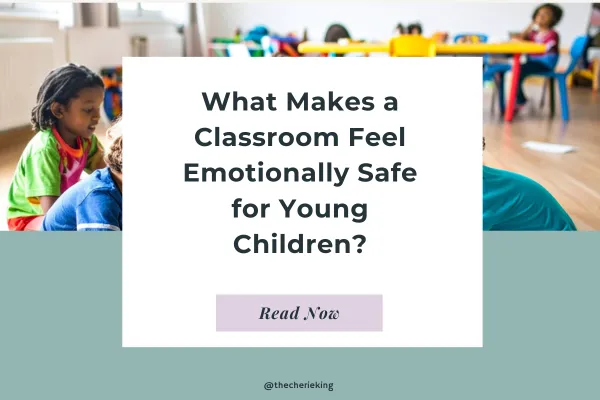
What Makes a Classroom Feel Emotionally Safe for Young Children?
What Makes a Classroom Feel Emotionally Safe for Young Children?
When children feel emotionally safe, their brains are free to learn, connect, and explore.
But emotional safety isn’t something we can see, it’s something children feel.
An emotionally safe classroom tells every child, “You belong here. You are seen, heard, and valued.”

Below are 10 practical ways to create that sense of safety in your early years or K–2 classroom, backed by what we know from neuroscience and attachment theory, and grounded in what actually works.
1. Start with You: Your Calm Sets the Tone
Children borrow your calm before they find their own. When your nervous system is steady, theirs can settle too.
How to:
Begin your day with a centring routine (deep breaths, a few moments of stillness, or gentle stretching).
Keep a calming visual nearby, a photo, affirmation, or a breathing card from your Calm Classroom Toolkit.
When challenges arise, pause and breathe before you speak. Your calm communicates safety more than your words ever could.
2. Create Predictable Routines
Predictability builds trust. Children feel safe when they know what’s coming next.
How to:
Use a visual schedule at eye level, with simple pictures.
Gently prepare children for transitions (“In two minutes, we’ll tidy up together”).
Keep routines consistent, but not rigid, flexibility shows responsiveness.
3. Greet Every Child by Name
Those few seconds at the door each morning can set the emotional tone for the whole day.
How to:
Offer a choice of greetings (wave, handshake, hug, elbow tap).
Make eye contact and say, “I’m so glad you’re here.”
For anxious children, quietly acknowledge their effort in arriving: “You did it, you came to school today.”
4. Use Warm, Regulated Voice and Body Language
Your tone and posture communicate safety faster than your words.
How to:
Get down to children’s level when speaking.
Keep your voice calm and steady, even when setting limits.
Avoid sudden loud instructions, a soft tone often draws attention more effectively.
5. Make Emotions Visible and Valid
Children feel emotionally safe when their feelings are acknowledged, not dismissed.
How to:
Use an emotions or feelings chart to help children name their emotions.
Reflect back what you see: “You look frustrated that the block tower fell.”
Model that all feelings are okay, but not all behaviours are.
6. Build Micro-Moments of Connection
Connection isn’t built in grand gestures, it’s in the small, consistent moments of noticing.
How to:
Smile when a child looks your way.
Acknowledge effort more than outcomes.
Offer spontaneous positive comments like, “I love how gently you’re using your hands.”
7. Design Spaces That Calm the Nervous System
Environment impacts emotion. The physical classroom can either soothe or overstimulate.
How to:
Soften harsh lighting; use natural light where possible.
Create a quiet “calm corner” with soft textures, breathing visuals, or emotion cards.
Keep displays uncluttered, visual noise can elevate anxiety.
8. Co-Regulate Before You Correct
Children can’t access logic when their nervous system is flooded.
How to:
When a child is dysregulated, lower your body, soften your voice, and breathe together.
Offer physical proximity before verbal correction.
Use language like, “Let’s take a breath together first.” Only once calm is restored can learning or reflection happen.
9. Build Belonging Through Inclusive Language
Belonging means every child knows they have a valued place in the group.
How to:
Use “we” and “our class” instead of “you” and “me.”
Display photos that reflect your class community.
Celebrate small acts of kindness: “When you helped Liam, it made our class feel really kind.”
10. Reflect, Repair, and Reconnect
Even in the safest classrooms, moments of rupture happen. Emotional safety is built in the repair.
How to:
Acknowledge your part if a moment felt tense (“I raised my voice before — I’m sorry. Let’s try again.”)
Model that relationships can recover from mistakes.
Reassure children that your care doesn’t change, even on hard days.
Final Thought
Emotional safety is the foundation of learning. When children feel safe, their brains can move out of survival and into curiosity, connection, and joy.
And that begins with you — the calm, caring adult who shows up each day.
Want practical tools to make this even easier?
Download your free Calm Classroom Toolkit a ready-to-use resource packed with visual supports, rituals, and regulation strategies to help you create an emotionally safe classroom where every child can thrive.
Connect with me:
Facebook: https://www.facebook.com/thecherieking
Instagram: https://www.instagram.com/thecherieking/